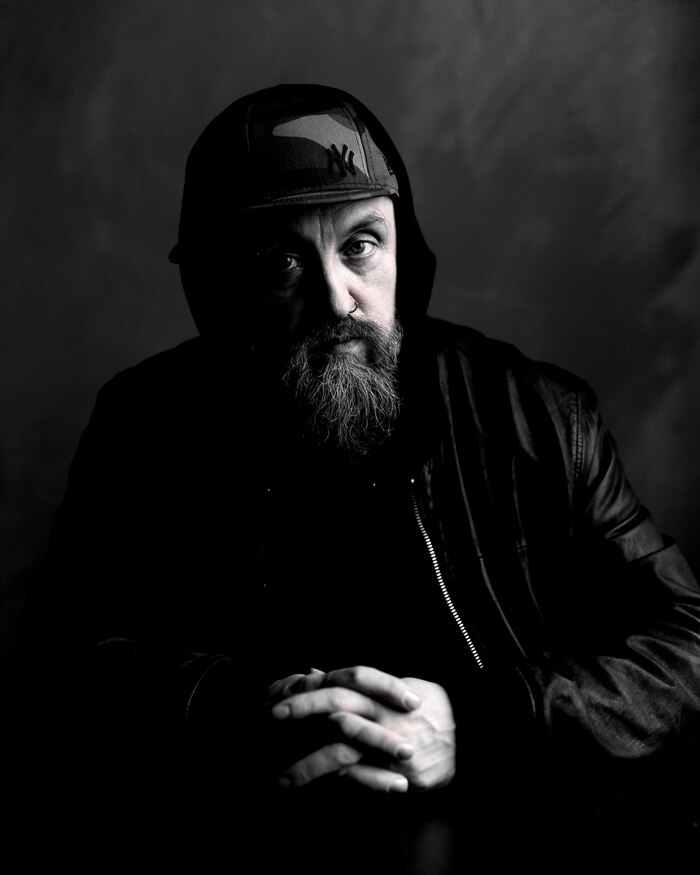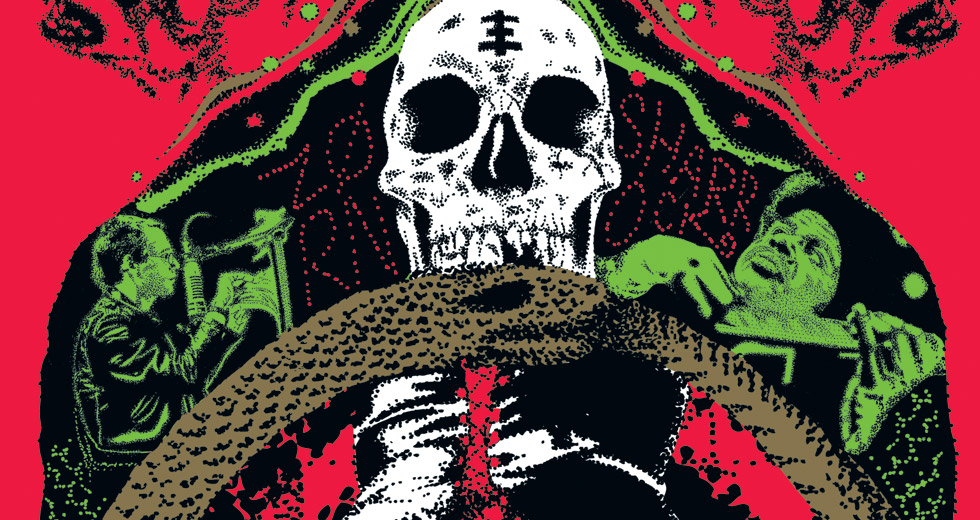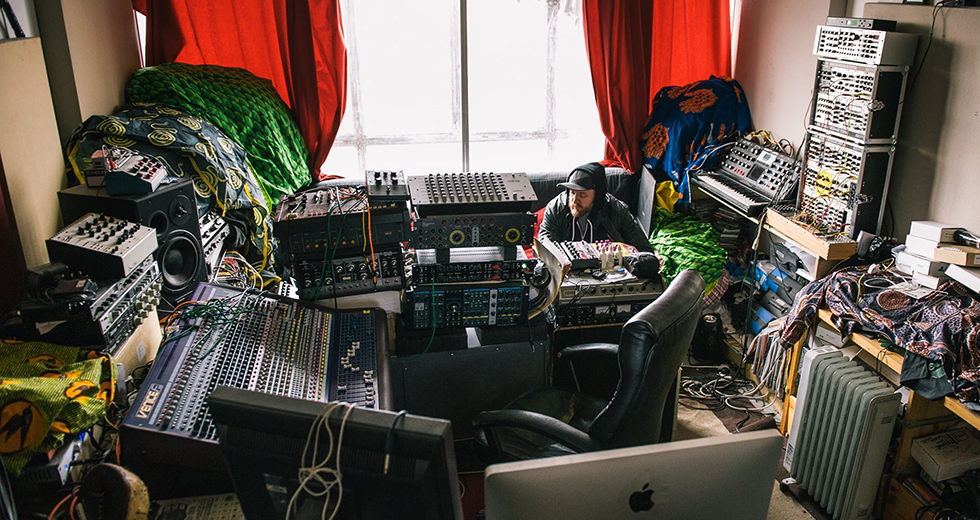Ambient Riff: The Bug on Fusing Metal and Dub
On the occasion of the series finale for his Red Bull Radio show, Kevin Martin discusses his lifelong love of heavy music and his latest project with Dylan Carlson of Earth

Kevin Martin is haunted by heavy sounds. The British producer and DJ has made music under a cluster of aliases since the early 1990s, from the industrial acid hip-hop of Techno Animal (with production partner Justin Broadrick, formerly of grindcore metal band Napalm Death and Godflesh, to reinforced dancehall and dubstep as The Bug, to vast post-rock dubscapes with King Midas Sound. A thread running through all his work is a sense of raw, crushing power, noises and riffs with a monumental heft; a sonic signature refined since the industrial rock and free jazz skronk of his first band, God. Heavy metal, both literal and figurative, has always been a factor in his material, though it’s mostly been fed through the mediums of soundsystem-splintering bass and the psychedelic buzz of electronic reverberation.
The atmosphere of ambient metal – where guitars are employed more for their heady, droning effect rather than as a melodic device — is a source of fascination for Martin, and lately, heavy guitar music has again become a prominent feature of his work, as he revives his collaboration with guitarist Dylan Carlson from American drone metal band Earth. A metal/dub hybrid first heard on 2014’s Boa/Cold EP, The Bug vs. Earth’s new album Concrete Desert is a fusion of brooding dub menace and hulking, lysergic guitars. The record has also proved a catalyst for the series finale of his Red Bull Radio Killing Sound show, previous installments of which have focused variously on sci-fi soundtracks (Inner Space), spoken word mixed with electronics (Poems & Drones) and the theme of melancholy (BLUE). The latest is Ambient Riff, in which Martin has invited some of the most respected metal and post-rock guitarists to contribute exclusive guitar parts for completely new productions. In this interview, Martin shares more about his love of metal, the correlation between ambient metal and dub and memories of the very last performance by Techno Animal.
Your Killing Sound radio show has focused on a different aspect of the music you’re into with each episode, and next one is Ambient Riff. What gave you the idea for this installment?
Predictability is the enemy of everything. For me it’s nice that no one really knows what the next show is going to be. Each show I took great delight in going from one extreme to another opposite extreme, but somehow there seems to be a mood that goes through it all. It’s hard for me to say what that mood is – it’s so personal – but there is an intrinsic atmospheric pressure that seems to follow everything I’ve been involved in. Ambient Riff was a result of the album I just completed with Dylan Carlson [of Earth], Concrete Desert.
The show is connected to my attraction to metal, but my general repulsion of much of it. The theatricals, the bad guitar solos, the bad vocals, the bad concepts, the bad presentations turn me off. Still, there’s something attractive about metal. If you talk about it in terms of density, mass, resonance, a lot of metal I would like, or the artists I end up gravitating towards, seem very minimal in their attitude towards it, and are ambivalent towards its past.
You’ve made lots of exclusive new music for the Ambient Riff show with some of the most prominent guitarists working in drone, heavy music and post-rock. Who are some of the artists who’ve contributed?
The artists I approached were guitarists I’m a huge fan of, that I feel approach the guitar as a textural tool as opposed to a wank-off instrument. Justin Broadrick from Godflesh is on there. The Body. A band called Monolord, which I’m a very big fan of. Christian Fennesz is on there. Heather Leigh is on there. Nadja is on there, and very importantly, Aaron Turner, who was in a band called Sumac and runs the Hydra Head label.
How did you work together?
I mailed each of them saying, “I want to do a radio show where I’m going to add music, but it’s going to be tonal, it’s not going to be structural. There’s not going to be any choruses.” I sent them a link to a track from The Bug vs. Earth record as a representation. It was premeditated. I said I wanted them to send me files of slowly evolving, hypnotic riffs that were like dread metal on downers. Massive riffs, preferably double-tracked with extra overdubs of feedback. I mentioned that I wanted to put together a show that would be textural, cinematic and would resonate deeply with people; that we’d be trying to find this new vocabulary for a new form of metal. What struck me is how uniform it’s going to end up sounding. Once this is done I want to try to release it as an album.
When people talk about heavy, it has this connotation of dark, ugly. I hate dark music. For me, that’s just theatre. I’m drawn to the colours blue and red in music. I like anger and melancholy. I don’t know why, maybe I didn’t get enough cuddles as a child. But I like music that’s beautiful, that resonates with your soul. I don’t like fake theatrical bollocks. The real joy of what’s come together here is that they’re beautiful tracks, mesmerising, extremely hypnotic. I believe that people that wouldn’t listen to metal will love this.
If anything, I’m trying to make the metal album I’ve never heard anywhere else with this radio show. The people I approached were all madly enthusiastic and really generous in how they worked at it. Some people like Monolord have no idea of my background or where I came from, but knew I was passionate about their music and I’d heard something in it. On the other hand, Nadja, or Justin with his Final project, or Fennesz, they’re very used to doing music that isn’t like metal at all, an impressionistic canvas. For this particular show and idea, I wanted something that would suck you into its vortex.
Without Justin Broadrick I would never have become a producer.
Ambient metal uses the guitar in a different way, as a tone or frequency rather than a specific melodic idea. Is it the imaginative, non-typical use of the instrument that appeals to you?
Without a doubt. Going back to when I formed the band God, as I see it now in hindsight, that was just therapy, man: letting out a lot of steam and getting a lot of shit out of my system. Once I started working on Techno Animal, I realised it was production I was more interested in than being a vocalist. With Justin, particularly when we worked together as Techno Animal, we became obsessive about texture and the grain of sound. Music didn’t need to be about structure. When we started Techno Animal – for Justin, anyway – it was a kick back against the constrictions in metal. He was one of the three guys who formed Napalm Death. God was my band, and my experience had been frustrating because I wanted to experiment more, whereas I had a full band that wanted their parts kept as they were. They were cool about me doing whatever the fuck I liked, but I still felt this pressure to not just butcher the components that were on tape. Before Techno Animal was a time when we both became addicted to finding any musics that were not structural, not about melody, not about conservative hooks. We started getting heavily into contemporary classical, world music, ambient, electronic music. That’s where we realised that if you make electronic music, one of the biggest challenges of all is how you can make it your own. That is really to do with trying to find your signature sound, for a signature sound comes from the approach to the finish of what you’re working on. The question of texture comes up.
You played the last ever Techno Animal show this month at your Pressure night at Gretchen in Berlin. What prompted the revival of the project?
We’ve been working on and off for a while. Justin was on [The Bug releases] Catch a Fire and Angels & Devils. We’re like brothers, really. Because he’s younger than me he feels like my younger brother, but actually he’s more experienced, I learned everything I know through him. Without him I would never have become a producer. When we did the previous Techno Animal show – I don’t know how many years ago it was – he couldn’t make it because he couldn’t set foot on a plane, he was so phobic. I had to do it on my own. At that time we’d become really disenchanted with Techno Animal. We were too noisy for hip-hop people and too hip-hop for noisy people. There wasn’t an audience,or potential to get shows on a regular basis. No one gave a fuck. We also didn’t want to repeat ourselves. In the subsequent years it’s been mad how much interest there’s been in the project. It’s been talked about more now than it ever was at the time. Any mention of Death Grips by anyone with a proper knowledge in music mentions Techno Animal as having done it before. I’m not trying to dis them – Death Grips are fantastic. All I’m saying is people have mentioned us. We stopped ’cause no one gave a shit. And to be honest we were just bored of playing to white dudes dressed in black. It became a chore. We sacked it off.
How was the show? Did it feel good to play live again?
Me and Justin were absolutely shitting ourselves beforehand at the prospect of playing together again after such a lengthy hiatus, but once the relentless bass grind of our opener “Demonoid” kicked in, we actually found new ways to intensify our back catalogue into a nastier, louder and certainly more extreme version of any shows that had gone before. We both agreed afterwards that it was one of the finest shows we had ever played, rivaling our infamous Sonar appearance many moons ago for sheer madness. What was particularly great was it felt like we had never stopped. And the crowd were a real mix of b-boys, metal heads, club girls, dubstep headnodders, alternatives and reggae fans. A super-positive freakout session, not just moody, po-faced.
The material you’ve made with Techno Animal, The Bug, King Midas Sound and other monikers has often had a backbone of dub reggae or dancehall. Do you see a correlation between ambient metal and dub?
There’s a massive correlation. Dylan [Carlson] is a dub fan. We were rehearsing for our CTM show recently at my studio in Berlin. I asked him what he was working on at the moment, and he said, “I’m working on the next Earth record, and it’s combining my love of dub and Miles Davis.” He started playing me some shit that was mindblowing on his guitar. When I first met Justin, we both talked about our love of dub. My entry point to reggae was productions by King Tubby, Scientist, Lee Perry. Justin was a massive fan of that stuff and we wanted it to be very much involved with Techno Animal. And at the same time you’ve got Al Cisneros, from OM and Sleep, who is also a massive reggae fan. He does solo dub tunes. It’s interesting to me that straightaway you’ve got Dylan, Justin, Al who are dub fans. I think what we’re talking about is the use of space. What you don’t add is more important. It’s a minimalism, reducing metal to this core intent and textural weight.
The spaciousness of a slow riff has more time to lodge itself in your cerebrum and your chest.
I’ve realised looking back that I seem to be very much attracted to riffs. I was a jazz obsessive and the first instrument I played was sax, and when I first moved to London for years I would go to as many free or experimental jazz shows and traditional shows as I could. But I realised as time went on that instead of John Coltrane’s freest and maddest albums, I would prefer his Africa Brass. Or Alice Coltrane’s Journey in Satchidananda. They were built on hypnotic, repetitive riffs, which have the same effect as a drug hit on me. It’s that grinding, cyclical, mesmeric [sound], tapping into the serotonin in your brain. Riffs in jazz, riffs in punk, I seem to gravitate towards heavy ones, ones that resonate. The reason I like slow music is I feel it resonates deeply. The spaciousness of a slow riff has more time to lodge itself in your cerebrum and your chest. Fast music becomes a fast thrill policy. That’s great, but it doesn’t stay with me. Slow music gives me time to swim in it.
Your new record as The Bug vs. Earth, Concrete Desert, was the inspiration for the Ambient Riff show. How did this collaboration come about?
It was through the guy I work with on my artwork, Simon Fowler. He’s a very good friend of Dylan’s. It was through casual conversations that I let it be known I was a massive fan of what Dylan was doing. He then let me know that Dylan had come to a Midas show and was really into King Midas Sound, and then I heard he’d put a King Midas Sound track on a podcast. We reached out to each other. We did the one 12" a couple of years ago and the response was unexpectedly great.
Like most things I try to work with musically, it’s trying to find something no one else is doing. When I started working as the Bug, I thought, “I like this about bashment, I like this about Jamaican dancehall music. But what if it wasn’t so melodic, what if wasn’t cheesy, what if it was heavy as fuck?” It’s imagining what isn’t around that I would want to hear.
I think Justin was quite surprised that I worked with Dylan, because he knows I’ve got this strange relationship with guitars. It’s been publicised that my mum bombarded me with the worst rock music and heavy metal as a kid. That’s probably what drove me towards Crass, Throbbing Gristle and Cabaret Voltaire, the hatred of guitars and the hatred of rock riffs. It took me years to be able to listen to that shit. Dylan, in a way, his approach is a very traditional one to guitar playing, his melodic sensibility. It’s actually not a radical “anti” way of playing guitar. But I’m captivated by the haunting quality of his melodies. There’s a sort of drugginess to Earth that I really love. I like that disorientation I get when I listen to his music.
There happened to be a point at which we could find the time when we weren’t working on something to commit to working on this album together. What was really cool with Dylan, he was very open to, as he put it, “be a sideman in this project.” I’m the one who has pushed it in a certain direction, scrambled the jigsaw and put it back together again sonically. He was very accommodating about me doing whatever I wanted with his guitar parts. Everything I did do with his guitar parts was done out of maximum respect. Considering what he put his guitar down onto, the end result is extremely different to that. It underwent very big transformations from the point at which I came back from the States and worked on the album proper.
What’s the next step in your collaborations with Justin now that Techno Animal has been put to rest?
Having worked together much more often lately and having been in much more contact, Justin and I began talking about a new project, which will be Zonal. We’ve already started on tracks. I don’t want to say too much about it right now. We’ve already spoken to a vocalist who’s agreed to work with us that we’re really happy about. There’s a few other surprise vocalists. It’s going to be an extension of Techno Animal – it’s not gonna be radical in its difference. But it is going to be different, too. We thought that would be a great way to bury the past and proclaim the future. Techno Animal is dead, long live Zonal!

